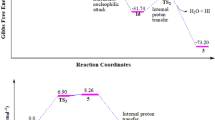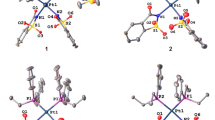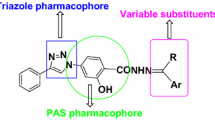Abstract
Salicylic acid (SA) remains one of the most fruitful natural compounds to generate drug molecules with versatile activities. In this study, effective synthesis of SA and acetylsalicylic acid (ASA) derivatives with a carrier triphenylphoshonium (TPP) group was proposed. A series of SA and ASA conjugates linked with the TPP group via alkyl chain linker (C3-C10) was synthesized. The conjugates showed enhanced TPP-mediated cytotoxicity towards MCF-7, Caco-2, PC-3 cells in proportion to the linker length. 7e, 8e (C9), and 7f (C10) were the most active against the cancer cells with IC50 = 0.6–1.9 µM while were less toxic for HSF. Similarly, antibacterial (bactericidal) activity of the compounds against S. aureus increased with the linker elongation. The lowest MIC for SA and ASA derivatives were 4 and 1 µM, respectively. The TPP conjugates induced early linker length-dependent mitochondria depolarization and concurrent superoxide radical production in the cancer cells. The most lipophilic conjugates were found to specifically interact with ROS probe 2′,7′-dichlorofluorescin diacetate, forming mixed aggregates with the probe and inhibiting its fluorescence upon oxidation. These interactions were exploited to probe the compounds inside living cells. The results identify 7e and 7f as promising mitochondria-modulating and anticancer agents with increased cellular availability.






Similar content being viewed by others
References
Hayat S, Ahmad A. Salicylic acid—a plant hormone. Netherlands: Springer; 2007.
Duthie GG, Wood AD. Natural salicylates: foods, functions and disease prevention. Food Funct. 2011;2:515–20. https://doi.org/10.1039/C1FO10128E.
Awtry EH, Loscalzo J. Aspirin. Circulation. 2000;101:1206–18. https://doi.org/10.1161/01.cir.101.10.1206.
Sun G, Zhang S, Xie Y, Zhang Z, Zhao W. Gallic acid as a selective anticancer agent that induces apoptosis in SMMC-7721 human hepatocellular carcinoma cells. Oncol Lett. 2016;11:150–8. https://doi.org/10.3892/ol.2015.3845.
Ghasemzadeh A, Jaafar HZE, Karimi E. Involvement of salicylic acid on antioxidant and anticancer properties, anthocyanin production and chalcone synthase activity in ginger (Zingiber officinale Roscoe) varieties. Int J Mol Sci. 2012;13:14828–44. https://doi.org/10.3390/ijms131114828.
Holmes MD, Chen WY, Li L, Hertzmark E, Spiegelman D, Hankinson SE. Aspirin intake and survival after breast cancer. J Clin Oncol. 2010;28:1467–72. https://doi.org/10.1200/JCO.2009.22.7918.
Chan AT, Ogino S, Fuchs CS. Aspirin use and survival after diagnosis of colorectal cancer. JAMA. 2009;302:649–58. https://doi.org/10.1001/jama.2009.1112.
Thun MJ, Henley SJ, Patrono C. Nonsteroidal anti-inflammatory drugs as anticancer agents: mechanistic, pharmacologic, and clinical issues. J Natl Cancer Inst. 2002;94:252–66. https://doi.org/10.1093/jnci/94.4.252.
Roth GJ, Majerus PW. The mechanism of the effect of aspirin on human platelets. I. Acetylation of a particulate fraction protein. J Clin Investig. 1975;56:624–32. https://doi.org/10.1172/JCI108132.
Kuznetsov HS, Marsh T, Markens BA, Castaño Z, Greene-Colozzi A, Hay SA, et al. Identification of luminal breast cancers that establish a tumor-supportive macroenvironment defined by proangiogenic platelets and bone marrow–derived cells. Cancer Discov. 2012;2:1150–65. https://doi.org/10.1158/2159-8290.CD-12-0216.
Coppinger JA, O’Connor R, Wynne K, Flanagan M, Sullivan M, Maguire PB, et al. Moderation of the platelet releasate response by aspirin. Blood. 2007;109:4786–92. https://doi.org/10.1182/blood-2006-07-038539.
McCarty MF, Block KI. Preadministration of high-dose salicylates, suppressors of NF-κB activation, may increase the chemosensitivity of many cancers: an example of proapoptotic signal modulation therapy. Integr Cancer Ther. 2006;5:252–68. https://doi.org/10.1177/1534735406291499.
Kopp E, Ghosh S. Inhibition of NF-kappa B by sodium salicylate and aspirin. Science. 1994;265:956–9. https://doi.org/10.1126/science.8052854.
Hawley SA, Fullerton MD, Ross FA, Schertzer JD, Chevtzoff C, Walker KJ, et al. The ancient drug salicylate directly activates AMP-activated protein kinase. Science. 2012;336:918–22. https://doi.org/10.1126/science.1215327.
Petrescu I, Tarba C. Uncoupling effects of diclofenac and aspirin in the perfused liver and isolated hepatic mitochondria of rat. Biochim Biophys Acta. 1997;1318:385–94. https://doi.org/10.1016/s0005-2728(96)00109-0.
Dikshit P, Chatterjee M, Goswami A, Mishra A, Jana NR. Aspirin induces apoptosis through the inhibition of proteasome function. J Biol Chem. 2006;281:29228–35. https://doi.org/10.1074/jbc.M602629200.
Raza H, John A, Benedict S. Acetylsalicylic acid-induced oxidative stress, cell cycle arrest, apoptosis and mitochondrial dysfunction in human hepatoma HepG2 cells. Eur J Pharmacol. 2011;668:15–24. https://doi.org/10.1016/j.ejphar.2011.06.016.
Castoldi F, Pietrocola F, Maiuri MC, Kroemer G. Aspirin induces autophagy via inhibition of the acetyltransferase EP300. Oncotarget. 2018;9:24574-5. https://doi.org/10.18632/oncotarget.25364.
Ekinci D, Şentürk M, Küfrevioğlu Öİ. Salicylic acid derivatives: synthesis, features and usage as therapeutic tools. Exp Opin Ther Pat.2011;21:1831–41. https://doi.org/10.1517/13543776.2011.636354.
Guo ZH, Yin Y, Wang C, Wang PF, Zhang XT, Wang ZC, et al. synthesis and molecular docking of salicylic acid derivatives containing metronidazole as a new class of antimicrobial agents. Bioorg Med Chem. 2015;23:6148–56. https://doi.org/10.1016/j.bmc.2015.07.075.
Shchegol’kov EV, Shchur IV, Burgart YV, Saloutin VI, Trefilova AN, Ljushina GA, et al. Polyfluorinated salicylic acid derivatives as analogs of known drugs: Synthesis, molecular docking and biological evaluation. Bioorg Med Chem. 2017;25:91–9. https://doi.org/10.1016/j.bmc.2016.10.014.
Sharma H, Patil S, Sanchez TW, Neamati N, Schinazi RF, Buolamwini JK. Synthesis, biological evaluation and 3D-QSAR studies of 3-keto salicylic acid chalcones and related amides as novel HIV-1 integrase inhibitors. Bioorg Med Chem. 2011;19:2030–45. https://doi.org/10.1016/j.bmc.2011.01.047.
Ott I, Kircher B, Bagowski CP, Vlecken DHW, Ott EB, Will J, et al. Modulation of the biological properties of aspirin by formation of a bioorganometallic derivative. Angew Chem Int Ed. 2009;48:1160–3. https://doi.org/10.1002/anie.200803347.
Zielonka J, Joseph J, Sikora A, Hardy M, Ouari O, Vasquez-Vivar J, et al. Mitochondria-targeted triphenylphosphonium-based compounds: syntheses, mechanisms of action, and therapeutic and diagnostic applications. Chem Rev. 2017;117:10043–120. https://doi.org/10.1021/acs.chemrev.7b00042.
Reily C, Mitchell T, Chacko BK, Benavides GA, Murphy MP, Darley-Usmara VM. Mitochondrially targeted compounds and their impact on cellular bioenergetics. Redox Biol. 2013;1:86–93. https://doi.org/10.1016/j.redox.2012.11.009.
Fuentes-Retamal S, Sandoval-Acuña C, Peredo-Silva L, Guzmán-Rivera D, Pavani M, Torrealba N, et al. Complex mitochondrial dysfunction induced by TPP+-gentisic acid and mitochondrial translation inhibition by doxycycline evokes synergistic lethality in breast cancer cells. Cells. 2020;9:407–30. https://doi.org/10.3390/cells9020407.
Sandoval-Acuña C, Fuentes-Retamal S, Guzmán-Rivera D, Peredo-Silva L, Madrid-Rojas M, Rebolledo S, et al. Destabilization of mitochondrial functions as a target against breast cancer progression: role of TPP+-linked-polyhydroxybenzoates. Toxicol Appl Pharm. 2016;309:2–14. https://doi.org/10.1016/j.taap.2016.08.018.
Pugachev MV, Shtyrlin NV, Sysoeva LP, Nikitina EV, Abdullin TI, Iksanova AG, et al. Synthesis and antibacterial activity of novel phosphonium salts on the basis of pyridoxine. Bioorg Med Chem. 2013;21:4388–95. https://doi.org/10.1016/j.bmc.2013.04.051.
Tsepaeva OV, Nemtarev AV, Salikhova TI, Abdullin TI, Grigor’eva LR, Khozyainova SA, et al. Synthesis, anticancer and antibacterial activity of betulinic and betulonic acid C-28-triphenylphosphonium conjugates with variable alkyl linker length. Anticancer Agents Med Chem. 2020;20:286–300. https://doi.org/10.2174/1871520619666191014153554.
Tan W, Zhang J, Luan F, Wei L, Chen Y, Dong F, et al. Design, synthesis of novel chitosan derivatives bearing quaternary phosphonium salts and evaluation of antifungal activity. Int J Biol Macromol. 2017;102:704–11. https://doi.org/10.1016/j.ijbiomac.2017.04.073.
Tan W, Li Q, Wei L, Wang P, Gao Z, Chen Y, et al. Synthesis, characterization, and antifungal property of starch derivatives modified with quaternary phosphonium salts. Mater Sci Eng: C. 2017;76:1048–56. https://doi.org/10.1016/j.msec.2017.03.181.
Akhmadishina RA, Garifullin R, Petrova NV, Kamalov MI, Abdullin TI. Triphenylphosphonium moiety modulates proteolytic stability and potentiates neuroprotective activity of antioxidant tetrapeptides in vitro. Front Pharmacol. 2018;9:1–13. https://doi.org/10.3389/fphar.2018.00115.
Grymel M, Zawojak M, Adamek J. Triphenylphosphonium analogues of betulin and betulinic acid with biological activity: a comprehensive review. J Nat Prod. 2019;82:1719–30. https://doi.org/10.1021/acs.jnatprod.8b00830.
Bittner Fialová S, Kello M, Čoma M, Slobodníková L, Drobná E, Holková I, et al. Derivatization of rosmarinic acid enhances its in vitro antitumor, antimicrobial and antiprotozoal properties. Molecules. 2019;24:1078–88. https://doi.org/10.3390/molecules24061078.
Tsepaeva O, Nemtarev A, Abdullin T, Grigoreva L, Kuznetsova E, Akhmadishina R, et al. Design, synthesis, and cancer cell growth inhibitory activity of triphenylphosphonium derivatives of the triterpenoid betulin. J Nat Prod. 2017;80:2232–39. https://doi.org/10.1021/acs.jnatprod.7b00105.
Garifullin R, Blokhin DS, Akhmadishina RA, Petrova NV, Kusova AM, Klochkov VV, et al. Effect of triphenylphosphonium moiety on spatial structure and biointeractions of stereochemical variants of YRFK motif. Eur Biophys J. 2019;48:25–34. https://doi.org/10.1007/s00249-018-1327-x.
Peredo-Silva L, Fuentes-Retamal S, Sandoval-Acuña C, Pavani M, Maya JD, Castro-Castillo V, et al. Derivatives of alkyl gallate triphenylphosphonium exhibit antitumor activity in a syngeneic murine model of mammary adenocarcinoma. Toxicol Appl Pharmacol. 2017;329:334–46. https://doi.org/10.1016/j.taap.2017.06.017.
Fueyo González FJ, Ebiloma GU, García CI, Bruggeman V, Sánchez Villamañán JM, Donachie A, et al. Conjugates of 2,4-dihydroxybenzoate and salicylhydroxamate and lipocations display potent antiparasite effects by efficiently targeting the trypanosoma brucei and trypanosoma congolense mitochondrion. J Med Chem. 2017;60:1509–22. https://doi.org/10.1021/acs.jmedchem.6b01740.
Ebiloma GU, Ayuga TD, Balogun EO, Gil LA, Donachie A, Kaiser M, et al. Inhibition of trypanosome alternative oxidase without its N-terminal mitochondrial targeting signal (ΔMTS-TAO) by cationic and non-cationic 4-hydroxybenzoate and 4-alkoxybenzaldehyde derivatives active against T. brucei and T. congolense. Eur J Med Chem. 2018;150:385–402. https://doi.org/10.1016/j.ejmech.2018.02.075.
Cortes LA, Castro L, Pesce B, Maya JD, Ferreira J, Castro-Castillo V, et al. Novel gallate triphenylphosphonium derivatives with potent antichagasic activity. PLoS ONE. 2015;10:e0136852 https://doi.org/10.1371/journal.pone.0136852.
Wodnicka A, Huzar E. Synthesis and photoprotective properties of new salicylic and vanillic acid derivatives. Curr Chem Lett. 2017;6:125–34. https://doi.org/10.5267/j.ccl.2017.3.002.
Smith RAJ, Hartley RC, Murphy MP. Mitochondria-targeted small molecule therapeutics and probes. Antioxid Redox Signal. 2011;15:3021–38. https://doi.org/10.1089/ars.2011.3969.
Manzano JI, Cueto-Diaz EJ, Olías-Molero AI, Perea A, Herraiz T, Torrado JJ, et al. Discovery and pharmacological studies of 4-hydroxyphenyl-derived phosphonium salts active in a mouse model of visceral leishmaniasis. J Med Chem. 2019;62:10664–75. https://doi.org/10.1021/acs.jmedchem.9b00998.
Jara JA, Castro-Castillo V, Saavedra-Olavarria J, Peredo L, Pavanni M, Jana F, et al. Antiproliferative and uncoupling effects of delocalized, lipophilic, cationic gallic acid derivatives on cancer cell lines. Validation in vivo in singenic mice. J Med Chem. 2014;57:2440–54. https://doi.org/10.1021/jm500174v.
Aykin-Burns N, Ahmad IM, Zhu Y, Oberley LW, Spitz DR. Increased levels of superoxide and H2O2 mediate the differential susceptibility of cancer cells versus normal cells to glucose deprivation. Biochem J. 2009;418:29–37. https://doi.org/10.1042/BJ20081258.
Plecitá-Hlavatá L, Ježek J, Ježek P. Pro-oxidant mitochondrial matrix-targeted ubiquinone MitoQ10 acts as anti-oxidant at retarded electron transport or proton pumping within Complex I. Int J Biochem Cell Biol. 2009;41:1697–707. https://doi.org/10.1016/j.biocel.2009.02.015.
Severin FF, Severina II, Antonenko YN, Rokitskaya TI, Cherepanov DA, Mokhova EN, et al. Penetrating cation/fatty acid anion pair as a mitochondria-targeted protonophore. PNAS. 2010;107:663–8. https://doi.org/10.1073/pnas.0910216107.
Fink BD, Herlein JA, Yorek MA, Fenner AM, Kerns RJ, Sivitz WI. Bioenergetic effects of mitochondrial-targeted coenzyme Q analogs in endothelial cells. J Pharmacol Exp Ther. 2012;342:709–19. https://doi.org/10.1124/jpet.112.195586.
Antonenko YN, Khailova LS, Knorre DA, Markova OV, Rokitskaya TI, Ilyasova TM, et al. Penetrating cations enhance uncoupling activity of anionic protonophores in mitochondria. PLoS ONE. 2013;8:e61902. https://doi.org/10.1371/journal.pone.0061902.g001.
Patková J, Anděl M, Trnka J. Palmitate-induced cell death and mitochondrial respiratory dysfunction in myoblasts are not prevented by mitochondria-targeted antioxidants. Cell Physiol Biochem. 2014;33:1439–51. https://doi.org/10.1159/000358709.
Trnka J, Elkalaf M, Anděl M. Lipophilic triphenylphosphonium cations inhibit mitochondrial electron transport chain and induce mitochondrial proton leak. PLoS ONE. 2015;10:e0121837. https://doi.org/10.1371/journal.pone.0121837.
Eruslanov E, Kusmartsev S. Identification of ROS using oxidized DCFDA and flow-cytometry, In: Armstrong D (eds.) Advanced protocols in oxidative stress II. Methods in Mol. Biol. 2010;594:57–72. https://doi.org/10.1007/978-1-60761-411-1_4.
Akhmadishina R, Kuznetsova E, Sadrieva G, Sabirzyanova L, Nizamov I, Akhmedova G, et al. Glutathione salts of O,O-diorganyl dithiophosphoric acids: Synthesis and study as redox modulating and antiproliferative compounds. Peptides. 2018;99:179–88. https://doi.org/10.1016/j.peptides.2017.10.002.
Valko M, Morris H, Cronin MT. Metals, toxicity and oxidative stress. Curr Med Chem. 2005;12:1161–208. https://doi.org/10.2174/0929867053764635.
Kamalov MI, Sadrieva GR, Pavlyuk AM, Salakhieva DV, Petrova NV, Abdullin TI. Synthesis and characterization of polyaspartic acid-histidine conjugate as an analog of antioxidant enzymes. Appl Biochem Microbiol. 2019;55:474–81. https://doi.org/10.1134/S0003683819050065.
Spivak AY, Nedopekina DA, Shakurova ER, Khalitova RR, Gubaidullin RR, Odinokov VN, et al. Synthesis of lupane triterpenoids with triphenylphosphonium substituents and studies of their antitumor activity. Russ Chem Bull. 2013;62:188–98. https://doi.org/10.1007/s11172-013-0028-y.
Millard M, Pathania D, Shabaik Y, Taheri L, Deng J, Neamati N. Preclinical evaluation of novel triphenylphosphonium salts with broad-spectrum activity. PLoS ONE. 2010;5:e13131. https://doi.org/10.1371/journal.pone.0013131.
Paterson DL. Resistance in gram-negative bacteria: enterobacteriaceae. Am J Infect Control. 2006;34:S20–8. https://doi.org/10.1016/j.ajic.2006.05.238.
Ma D, Cook DN, Hearst JE, Nikaido H. Efflux pumps and drug resistance in Gram-negative bacteria. Trends Microbiol. 1994;2:489–93. https://doi.org/10.1016/0966-842X(94)90654-8.
Dang T, Nizamov IS, Salikhov RZ, Sabirzyanova LR, Vorobev VV, Burganova TI, et al. Synthesis and characterization of pyridoxine, nicotine and nicotinamide salts of dithiophosphoric acids as antibacterial agents against resistant wound infection. Bioorg Med Chem. 2019;27:100–9. https://doi.org/10.1016/j.bmc.2018.11.017.
Galkina IV, Bakhtiyarova YV, Shulaeva MP, Pozdeev OK, Egorova SN, Cherkasov RA, et al. Synthesis and antimicrobial activity of carboxylate phosphabetaines derivatives with alkyl chains of various lengths. J. Chem. 2013:302937. https://doi.org/10.1155/2013/302937.
Kanazawa A, Ikeda T, Endo T. Synthesis and antimicrobial activity of dimethyl- and trimethyl-substituted phosphonium salts with alkyl chains of various lengths. Antimicrob Agents Chemother. 1994;38:945–52. https://doi.org/10.1128/AAC.38.5.945.
Acknowledgements
This work was supported by the Ministry of Education and Science of the Russian Federation (subsidies allocated to FRC Kazan Scientific Center of RAS and Kazan Federal University for the state assignments in the sphere of scientific activities (0671-2020-0063)), the Russian Foundation for Basic Research (grant no. 20-33-70194), and also performed according to the Russian Government Program of Competitive Growth of Kazan Federal University. RI acknowledges RFBR project No 19-34-90139 (analysis of oxidative stress in cell monolayers). The authors gratefully acknowledge the CSF-SAC FRC KSC RAS and Interdisciplinary Centre for Shared Use of Kazan Federal University.
Author information
Authors and Affiliations
Corresponding author
Ethics declarations
Conflict of interest
The authors declare that they have no conflict of interest.
Additional information
Publisher’s note Springer Nature remains neutral with regard to jurisdictional claims in published maps and institutional affiliations.
Supplementary information
Rights and permissions
About this article
Cite this article
Tsepaeva, O.V., Salikhova, T.I., Grigor’eva, L.R. et al. Synthesis and in vitro evaluation of triphenylphosphonium derivatives of acetylsalicylic and salicylic acids: structure-dependent interactions with cancer cells, bacteria, and mitochondria. Med Chem Res 30, 925–939 (2021). https://doi.org/10.1007/s00044-020-02674-6
Received:
Accepted:
Published:
Issue Date:
DOI: https://doi.org/10.1007/s00044-020-02674-6




